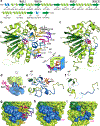Structural basis of 7SK RNA 5'-γ-phosphate methylation and retention by MePCE
- PMID: 30559425
- PMCID: PMC6339579
- DOI: 10.1038/s41589-018-0188-z
Structural basis of 7SK RNA 5'-γ-phosphate methylation and retention by MePCE
Abstract
Among RNA 5'-cap structures, γ-phosphate monomethylation is unique to a small subset of noncoding RNAs, 7SK and U6 in humans. 7SK is capped by methylphosphate capping enzyme (MePCE), which has a second nonenzymatic role as a core component of the 7SK ribonuclear protein (RNP), an essential regulator of RNA transcription. We report 2.0- and 2.1-Å X-ray crystal structures of the human MePCE methyltransferase domain bound to S-adenosylhomocysteine (SAH) and uncapped or capped 7SK substrates, respectively. 7SK recognition is achieved by protein contacts to a 5'-hairpin-single-stranded RNA region, thus explaining MePCE's specificity for 7SK and U6. The structures reveal SAH and product RNA in a near-transition-state geometry. Unexpectedly, binding experiments showed that MePCE has higher affinity for capped versus uncapped 7SK, and kinetic data support a model of slow product release. This work reveals the molecular mechanism of methyl transfer and 7SK retention by MePCE for subsequent assembly of 7SK RNP.
Conflict of interest statement
Declaration of Interests
The authors declare no competing interests.
Figures





References
-
- Schapira M Structural chemistry of human RNA methyltransferases. ACS Chem Biol 11, 575–582 (2016). - PubMed
-
- Shimba S, Buckley B, Reddy R, Kiss T & Filipowicz W Cap structure of U3 small nucleolar RNA in animal and plant cells is different. gamma-Monomethyl phosphate cap structure in plant RNA. J. Biol. Chem 267, 13772–13777 (1992). - PubMed
Publication types
MeSH terms
Substances
Grants and funding
LinkOut - more resources
Full Text Sources
Molecular Biology Databases
Research Materials
Miscellaneous

